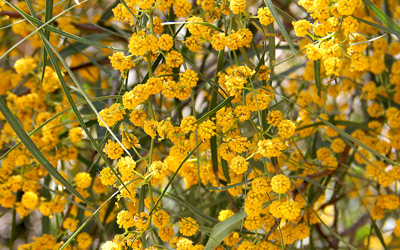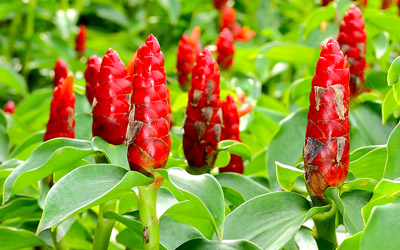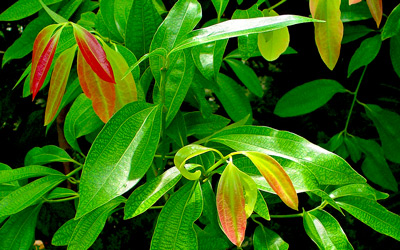The cultivation of ginseng not only requires patience but also close adherence to care requirements in order to achieve success. The following growing guidelines will help you to propagate, develop, and take care of ginseng at home.
1. Preparing the Soil
Both wild and Panax ginseng grow in forested areas with a great deal of shade and rich, moist soils. In order to grow ginseng, the planting site must have 70 - 85% shade. Any more than 25% sunlight can burn ginseng leaves and increase competition with other plants in the area.
The ideal condition for growing ginseng is in well-drained, sandy soils. If there are too many rocks in the soil, the soil temperature is easily altered by water buildup. Soil that is too sandy will allow the ginseng roots to grow with small branches on them, which significantly decreases their value. It is important to test the pH of the soil. The best pH range for ginseng growing should be 5.0 - 6.5. A pH higher than 6.5 could lead to physiological disorders, such as nutrient deficiency.
2. Planting
Planting Ginseng Outdoors
Growing ginseng can be accomplished through propagation with either the root or the seeds. While propagation using the root is a faster process, it is also significantly more expensive, and therefore, more people propagate it by seed.
The propagation of ginseng by seeds is a longer process because it requires stratification, which consists of simulating natural winter conditions that the seeds must endure before germination. The seeds only will sprout when the dormancy period is over. Ginseng seed stratification is most successful when done in the fall, any time before the soil freezes.
The ginseng seeds should be buried in the soil in a shaded area and checked on early the following spring. Some seeds may be ready for planting immediately, while the other seeds should be reburied until the next fall, when they will be stratified and ready to be planted.
For best results, the seeds should be planted immediately after stratification is finished. The seeds should be planted one-half to one inch (1.2 - 2.5 cm) deep, spaced one inch (2.5 cm) apart in rows six inches (15 cm) away from each other. Immediately cover the seeds with light mulch and one to two inches (2.5 - 5.0 cm) of leaves or straw.
3. Plant Care
Watering
Since ginseng plants grow best in shaded areas, their water needs are moderated. The soil should be kept moist and well-drained. Overhead watering and excessive irrigation should be avoided in order to prevent fungal diseases and root rot.
Fertilizing
The average amount of fertilizer used for growing ginseng is around 64 pounds (29 kg). If too much fertilizer is used, the ginseng roots will be poor quality, with possible defects such as a smooth root surface and low total ginsenosides, the compounds believed to carry many of ginseng's benefits. Fertilizers should be applied during the dormant season at least a couple of weeks before plants emerge.
Weed Control
Weeds are not a major threat for ginseng once the plant is well established; however, they can be controlled with mulching, hand weeding, or spraying herbicides.
4. Pest & Disease Control
With a long growth period, ginseng faces certain threats over the years that could harm it. Wildlife, pests, and diseases can do serious damage to ginseng plants; therefore, knowing how to possibly prevent or control damage while growing ginseng is essential.
Wildlife
Large deer populations may hinder ginseng cultivation by eating one-year-old plants. At only one year, ginseng plants usually die when browsed, but older plants often sprout back up after losing a year's growth.
Pests
Typically, the only pests that regularly attack ginseng plants are slugs. Large slug populations can be controlled with repellents. A recommended repellent for slug control is iron phosphate, which is certified for use on ginseng.
Diseases
The most significant common diseases that can affect ginseng are leaf blight, damping-off, and root rot.
Blight. Blight spores sprout on plant stems and leaves during hot, humid conditions and inhibit nutrient uptake. Plant the ginseng with ample space to allow air movement around the leaves to control blight.
Damping-off fungus. Beware of this fungus during cold, wet springs in the first year. The fungus causes ginseng stems to collapse and the tops to wither. Planting ginseng in well drained-soils and protecting it with light mulch will help prevent infection.
Root rot. Root rot is the least common of the three significant diseases affecting ginseng, but it can cause it to develop droopy rusty lesions, become rubbery, turn into black stubs, exude a smelly liquid, or disappear altogether. Infected plants must be immediately removed to stop the disease from spreading. Prevent root rot by avoiding poorly-drained planting areas and offsetting overly acidic soils with lime.
5. Harvest
Ginseng harvesting is conducted at different points of cultivation depending on the region and type. In Asia, Panax ginseng is harvested in the middle of October after six years of cultivation. In British Columbia and Ontario, harvesting will occur a bit earlier, at around four years of cultivation.
The easiest way to harvest ginseng is with a sharp needle-nosed spade, shovel, spade fork, or mattock after rainfall when the soil is wet and loose. Be careful not to cut the root during harvest by digging at least six inches (15 cm) from the base of the stem.
6. Storage
After harvesting ginseng, wash and dry the roots with low-pressure water. Dry the roots in an area with good air flow with temperatures kept between 70 - 95F (21 - 35C). Flip the roots after the first 36 hours of drying to avoid mold growth. The drying process can take anywhere from a few days to a few weeks, depending on the size of the ginseng root. After the ginseng is sufficiently dried, store the roots in paper bags or boxes.
Growing ginseng is a work of patience and it takes a lot of dedication, from the preparation of the seeds to the planting and growing process to ensure a successful cultivation. However, as your ginseng plants grow and thrive, you will be rewarded with one of the most valuable herbs in the world.





